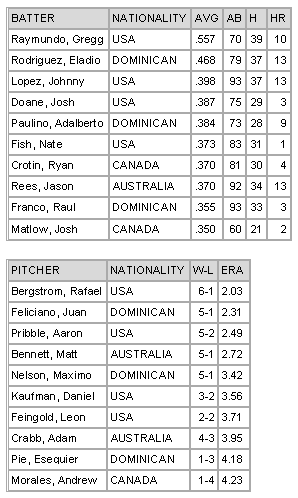
Errors
The first two weeks of the season (June 24th – July 6th) there was an average of 1.98 errors per team per game. The second two weeks there was an average of 1.16 errors per team per game. This is staggering improvement in a very short time. The reason? We had no spring training, never played with our teammates and had some jitters. I looked up what the average errors per game are for an A level minor league team in the states and found that the average Southern Atlantic League team commits 1.33 errors per game (nine innings) this year. Considering that the field conditions are superior in the states the error rate in the IBL is in range for what was expected for the caliber of play. Why did I do this bit of analysis? Well I noticed that the sloppy play both in terms of physical errors and mental errors has diminished greatly and I wanted to confirm and quantify my hunch.
The next step would be to check the error rates at each venue and see if playing at the various fields, which are vastly different in quality, effects the error rates. Analysis for another day.
Diverse Talent
Coming into the season I assumed the Dominican players would dominate the IBL. There were approximately 170 players, all with professional experience invited to the tryouts in the Dominican Republic. Over a two day period 16-18 of the players trying out were signed. Some of the players were top prospects in the US pro leagues and had there careers stymied because of visa issues not performance issues. These include Maximo Nelson of the Yankees clocked at the IBL All Star game throwing 96MPH and my teammate Abel Moreno who was the number 3 prospect in the Angels organization and whose change up was considered tops in the Angels system. He also throws in the low 90’s. Juan Feliciano another Dominican pitcher played last year in the Japanese Major League and has an impressive repertoire of pitches including a 93 mph fastball. Then there is Julio Guerrero, Vladimir’s brother, whose pedigree alone can make a pitcher shutter. I could go on but I hope you see why most assumed the Dominicans would lead the league in just about everything.
This is not what happened. Looking at the league leaders what jumps out at me is diversity. Below is a list of the top 10 batting and pitching leaders with there associated nationalities.

I am impressed with the Australians. I did not realize that there is high quality baseball coming from there. Currently there are over 80 players in the USA minor leagues hailing from Australia and at least three major leaguers.
As expected, the group that is struggling are the Israeli’s. Approximately 12% of the players came from the amateur Israeli league and the goal is to expose them to a higher caliber of baseball in order to elevate the knowledge and play in Israel.

BB’s and K’s
One thing I find puzzling is the high rate of walks being issued. The league is averaging 5.9 walks per 9 innings. The pitchers in the IBL could not have survived in their previous playing experiences with such an astronomical walk rate. So what happened to them?
Some can be attributed to the Israeli pitchers who lack the experience of their league mates. But even without the Israeli pitching, the rate is still far more than I would have expected. Take for example Abel Moreno, he issued just 54 bases on balls in 272 innings in the minor leagues for the Anaheim Angels. In the IBL he has issued 21 walks in the 27 innings he has pitched. A couple weeks ago we were sitting in the dugout together and he started venting about his struggles. He did not understand why his command has suffered.
I too have had severe issues with control. For me though, it is clear why. First I had a lack of confidence in my stuff so was scared to put anything over the plate. Then my approach to pitching was completely altered through some discussion with my manager and pitching coach. The reworking of my pitching was a flop that cost my team and myself a high price paid in bases on balls. After the All Star break I changed back to my original pitching style but with some added insights and so far it has worked beautifully. I imagine my experience is not unique and that other pitchers have struggled with confidence and reworking of mechanics.
There is another possible reason. The hitters are not that comfortable. A couple weeks ago an umpire told me he has never seen so many pitches being taken. When batters are taking marginal pitches there will be more walks issued. On the flip side, if this is true there should be an abnormally high rate of strikeouts as well. Turns out there are, there are 8 strikeouts per 9 innings pitched in the IBL. So why are batters taking so many pitches?
The first two weeks of the season (June 24th – July 6th) there was an average of 1.98 errors per team per game. The second two weeks there was an average of 1.16 errors per team per game. This is staggering improvement in a very short time. The reason? We had no spring training, never played with our teammates and had some jitters. I looked up what the average errors per game are for an A level minor league team in the states and found that the average Southern Atlantic League team commits 1.33 errors per game (nine innings) this year. Considering that the field conditions are superior in the states the error rate in the IBL is in range for what was expected for the caliber of play. Why did I do this bit of analysis? Well I noticed that the sloppy play both in terms of physical errors and mental errors has diminished greatly and I wanted to confirm and quantify my hunch.
The next step would be to check the error rates at each venue and see if playing at the various fields, which are vastly different in quality, effects the error rates. Analysis for another day.
Diverse Talent
Coming into the season I assumed the Dominican players would dominate the IBL. There were approximately 170 players, all with professional experience invited to the tryouts in the Dominican Republic. Over a two day period 16-18 of the players trying out were signed. Some of the players were top prospects in the US pro leagues and had there careers stymied because of visa issues not performance issues. These include Maximo Nelson of the Yankees clocked at the IBL All Star game throwing 96MPH and my teammate Abel Moreno who was the number 3 prospect in the Angels organization and whose change up was considered tops in the Angels system. He also throws in the low 90’s. Juan Feliciano another Dominican pitcher played last year in the Japanese Major League and has an impressive repertoire of pitches including a 93 mph fastball. Then there is Julio Guerrero, Vladimir’s brother, whose pedigree alone can make a pitcher shutter. I could go on but I hope you see why most assumed the Dominicans would lead the league in just about everything.
This is not what happened. Looking at the league leaders what jumps out at me is diversity. Below is a list of the top 10 batting and pitching leaders with there associated nationalities.

I am impressed with the Australians. I did not realize that there is high quality baseball coming from there. Currently there are over 80 players in the USA minor leagues hailing from Australia and at least three major leaguers.
As expected, the group that is struggling are the Israeli’s. Approximately 12% of the players came from the amateur Israeli league and the goal is to expose them to a higher caliber of baseball in order to elevate the knowledge and play in Israel.

BB’s and K’s
One thing I find puzzling is the high rate of walks being issued. The league is averaging 5.9 walks per 9 innings. The pitchers in the IBL could not have survived in their previous playing experiences with such an astronomical walk rate. So what happened to them?
Some can be attributed to the Israeli pitchers who lack the experience of their league mates. But even without the Israeli pitching, the rate is still far more than I would have expected. Take for example Abel Moreno, he issued just 54 bases on balls in 272 innings in the minor leagues for the Anaheim Angels. In the IBL he has issued 21 walks in the 27 innings he has pitched. A couple weeks ago we were sitting in the dugout together and he started venting about his struggles. He did not understand why his command has suffered.
I too have had severe issues with control. For me though, it is clear why. First I had a lack of confidence in my stuff so was scared to put anything over the plate. Then my approach to pitching was completely altered through some discussion with my manager and pitching coach. The reworking of my pitching was a flop that cost my team and myself a high price paid in bases on balls. After the All Star break I changed back to my original pitching style but with some added insights and so far it has worked beautifully. I imagine my experience is not unique and that other pitchers have struggled with confidence and reworking of mechanics.
There is another possible reason. The hitters are not that comfortable. A couple weeks ago an umpire told me he has never seen so many pitches being taken. When batters are taking marginal pitches there will be more walks issued. On the flip side, if this is true there should be an abnormally high rate of strikeouts as well. Turns out there are, there are 8 strikeouts per 9 innings pitched in the IBL. So why are batters taking so many pitches?


2 comments:
Well, there's a diverse assortment of playing in the league it seems. Hopefully, baseball will continue to grow in popularity and we'll see even more... Keep up the good work in the IBL!
Interesting how the error rate has dropped so quickly. It would quite likely drop even lower by the season's end.
Post a Comment